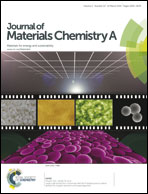High performance of Pt-free dye-sensitized solar cells based on two-step electropolymerized polyaniline counter electrodes
Abstract
A two-step cyclic voltammetry (CV) approach is employed in a quick and controllable electropolymerization of polyaniline (PANI) nanofibers with a short-branched structure onto fluorinated tin oxide (FTO) glass substrates as counter electrodes (CEs) for Pt-free dye-sensitized solar cells (DSSCs). In the two-step CV method, a small quantity of PANI as a function of the crystal nucleus in the crystal growth, is pre-electropolymerized under a suitably high potential for one cycle at the first-step, then subjected to the second-step for PANI electropolymerization at a low potential for a small number of scans. The well-controlled PANI nanofibers with high performance can be electropolymerized quickly using the two-step mode. The extensive CVs demonstrate the two-step PANI CE has superior electrocatalytic activity for the I3− reduction. Moreover, electrochemical impedance spectroscopy shows that the two-step PANI CE has a lower series resistance and charge-transfer resistance than the PANI CE prepared by conventional one-step CV electropolymerization. Therefore, the DSSC assembled with the two-step PANI CE exhibits an enhanced photovoltaic conversion efficiency of 6.21% (compared to 5.01% for the DSSC with the one-step PANI CE), up to ∼97% of the level of the DSSC using Pt CE. As the result, the two-step CV electropolymerized PANI CE can be considered as a promising alternative CE for Pt-free DSSCs.


 Please wait while we load your content...
Please wait while we load your content...